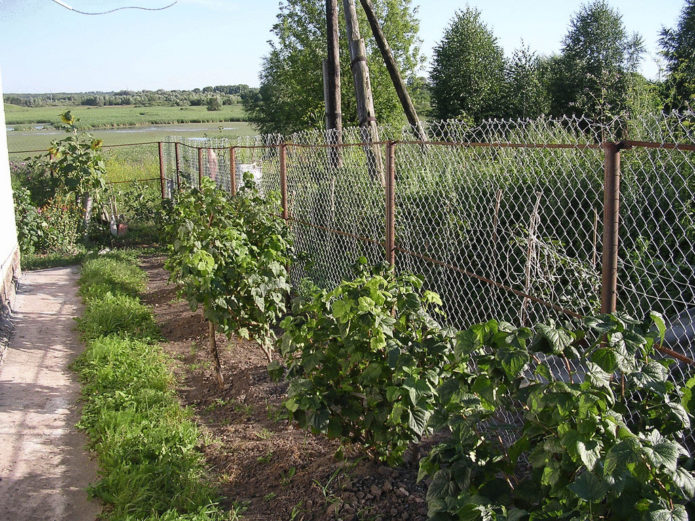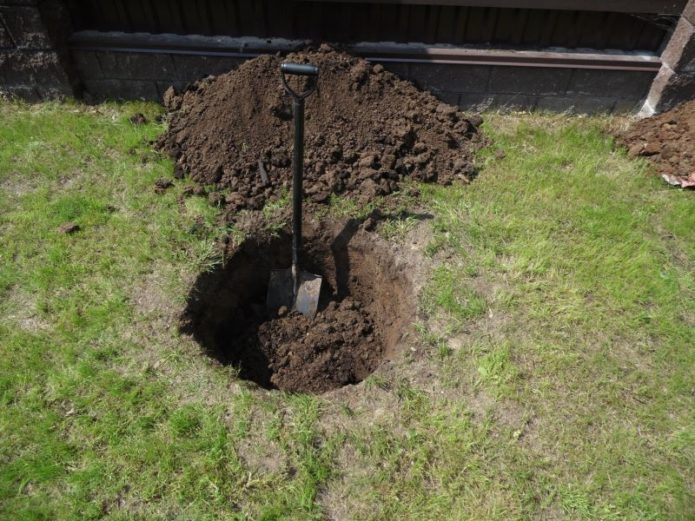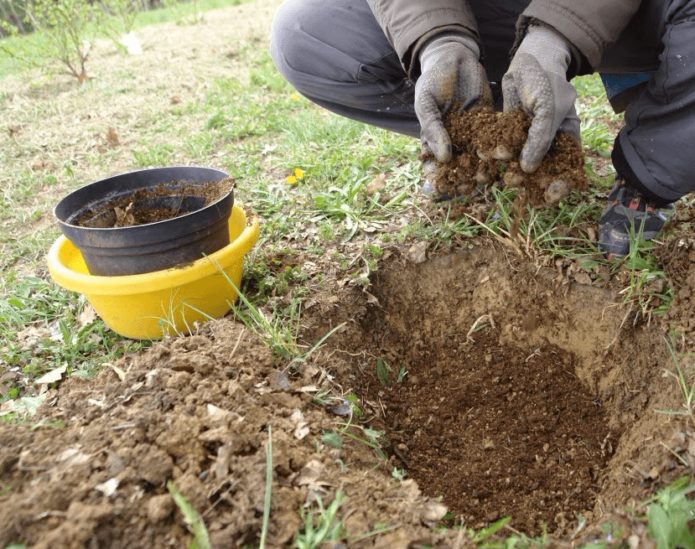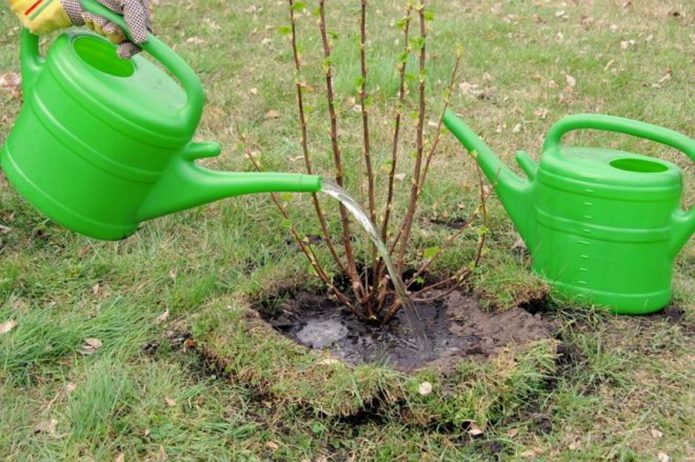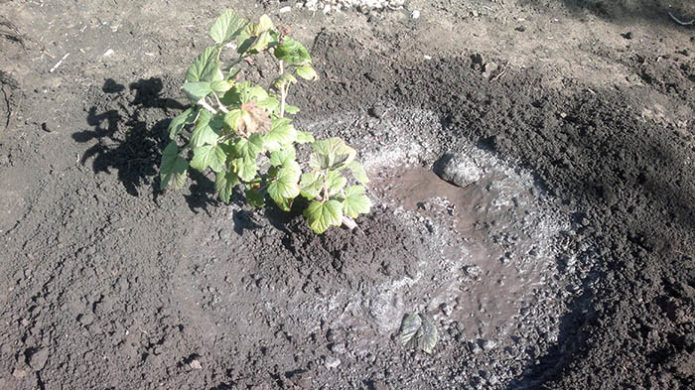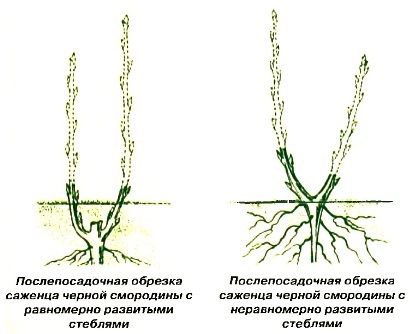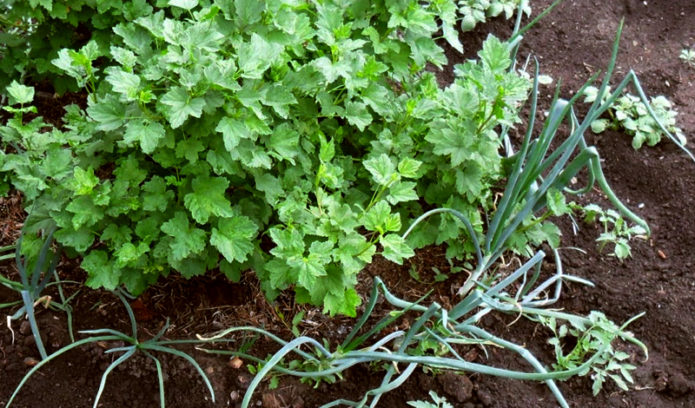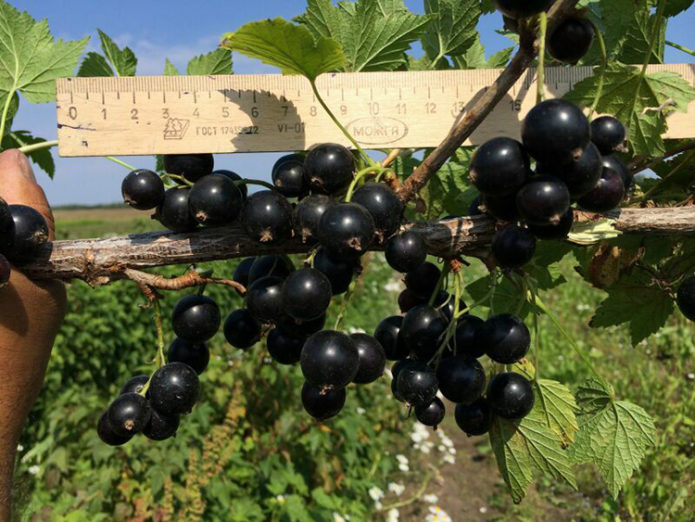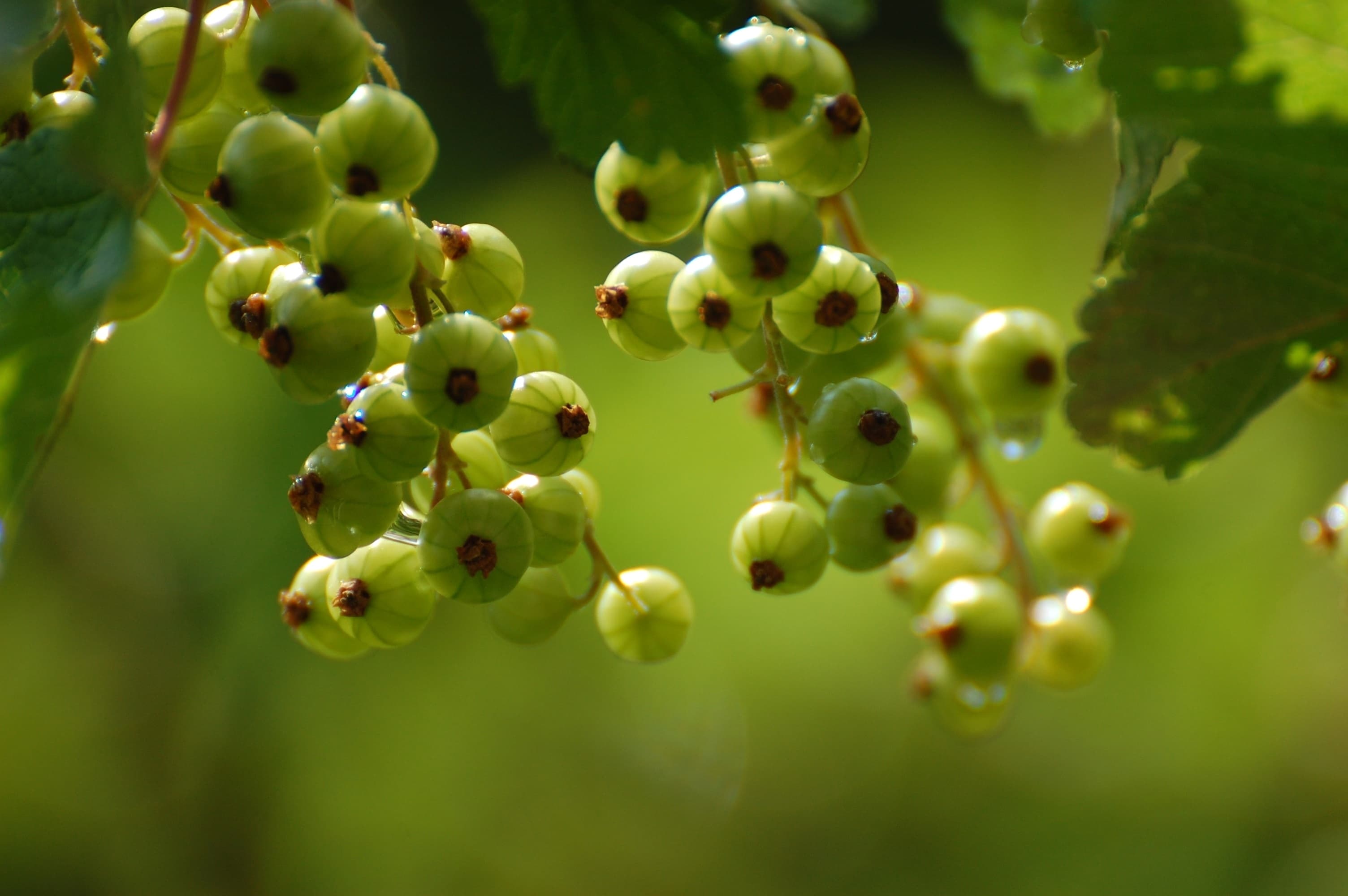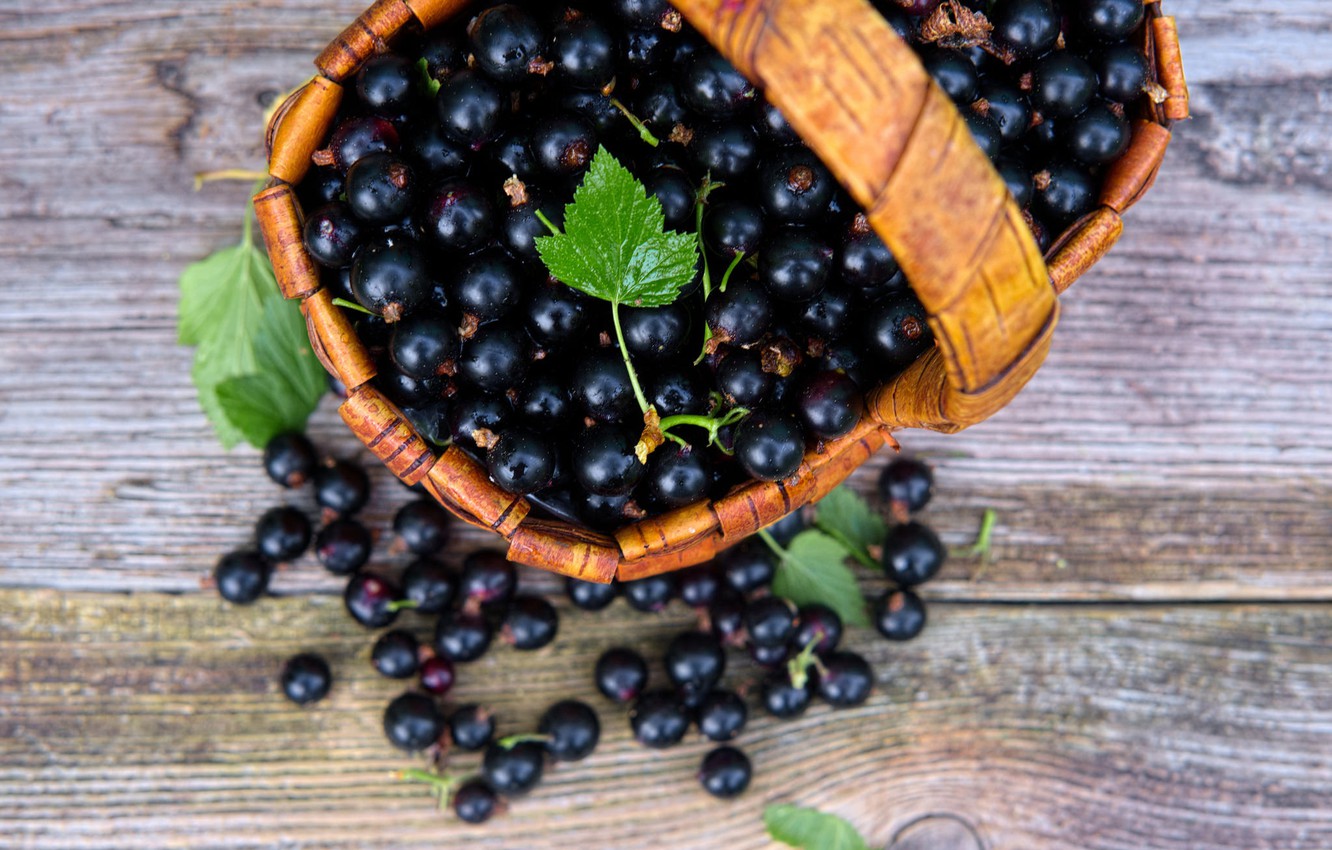Black currant is a representative of berry bushes, one of the first to appear on the new garden plot. A relatively unpretentious plant, after a couple of years it brings full yields of berries with a huge content of vitamins. Planting ready-made blackcurrant seedlings is quite simple, but must be done according to all the rules.
Content
Features of planting black currants in different seasons: spring, summer and autumn
Autumn is considered the best time to plant black currants. It is much more difficult to plant it in the spring, and in the summer it is only possible to carefully plant seedlings with a closed root system, which are sold in containers. In the fall, it is much easier to work with the soil: after all, spring planting is possible only as long as the buds on the seedlings have not swollen, and at this time the earth is soggy, and in some places it has not yet completely thawed. In principle, there are no other obstacles to spring planting.
The spring planting pit must be prepared in the fall, and for the fall, you can choose the time for this throughout the summer season. Indeed, before planting a seedling, the soil in the planting pit must stand, the fertilizers in it must disperse, and the biological balance must be almost completely established. The only relative disadvantage of autumn planting is that the planted bush must be well covered for the winter: it, as a rule, does not have time to take root completely, and the roots spread over considerable distances.
Technology of growing currants, features of planting and caring for shrubs in different regions:https://flowers.desigusxpro.com/en/yagody/smorodina/uhod-za-smorodinoy-vesnoy-borba-s-vreditelyami.html
Autumn planting should be carried out about two months before the onset of real frosts. Just by this time, the growth processes in currants freeze, only roots really grow, and transplanting a bush to a permanent place practically does not pose any stress for it. In the spring, it is dangerous to delay planting sometimes for one day: the appearance of a green cone from the buds indicates that this is the deadline for planting, and the leaves that begin to open say that planting should be postponed to autumn.
It is much safer to plant seedlings with a closed root system in the spring. They are now often found on sale: seedlings are in containers, pots, or just plastic bags with soil. Such seedlings are planted together with an earthen clod, carefully removing it from the container. If at the same time the roots are not damaged, the plant continues life in a new place, as if nothing had happened.Therefore, planting such seedlings is possible in summer, except for especially hot days.

The advantage of potted seedlings is that if they can be removed without damaging the roots, they hardly feel transplanted to a permanent place.
As a rule, an earthen lump in a container contains significant amounts of nutrients, and therefore the amount of fertilizer applied to the pit is reduced by one and a half times. It is only important to navigate when to water or dry the seedling before planting, so as not to destroy the earthen lump when removed from the container.
How to store blackcurrant planting material before planting
It is better not to buy blackcurrant seedlings for a long time: any storage outside the normal state will be harmful. Although, of course, situations are different. But if before planting it is necessary to store the seedlings for more than 3-4 days, it is better to dig them in: cover them almost completely (at least up to half the length of the branches) with earth in the pit and water them. If there are leaves on the seedling, they are immediately carefully cut off so that there is no excess surface evaporating moisture.
How to choose and plant currant seedlings correctly:https://flowers.desigusxpro.com/en/yagody/smorodina/posadka-smorodinyi-vesnoy-sazhentsami.html
For storage for several days, the roots of the seedling must be dipped in a clay mash. After that, it is best to sprinkle them with sawdust and place them in a regular plastic bag. Keep in a cool place. If there is no talker or sawdust, the roots are wrapped in a wet rag and also put in a bag.
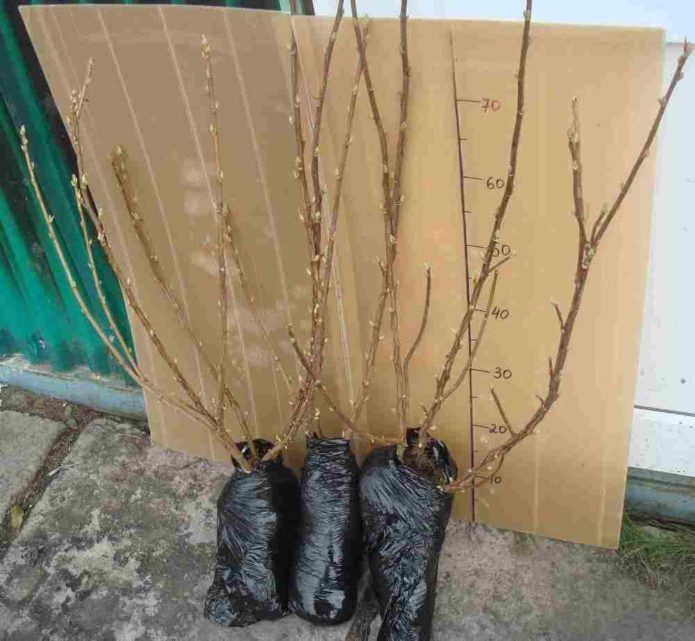
If seedlings without an earthen clod are purchased, they should be placed in plastic bags as soon as possible.
If we are not talking about seedlings, but about cuttings (after all, currants in the fall are very easy to propagate on their own: you just need to purchase fresh, just cut cuttings of the desired variety and stick them into moist, loose soil), it is even easier here. The cuttings are wrapped in a damp cloth, and then in a plastic bag. But it is advisable to land them in the next 2-3 days.
Planting technology of black currant
Planting currants in any season is carried out according to a single algorithm and includes:
- selection of a site for the berry and its preparation;
- digging a planting pit, applying fertilizers to it;
- preparation of a seedling for planting;
- placing the seedling in a hole at the required depth at the right angle;
- backfilling the roots with fertile soil;
- watering the seedling after planting;
- soil mulching;
- pruning.
Seat selection
Compared to other species, black currants are less capricious, but choosing the right site for it is crucial. It does not tolerate waterlogging, but the soil under it must be constantly moderately moist. Groundwater should not approach the roots, that is, lie closer than 1–1.5 m from the soil surface. The site should be well lit by the sun, but light partial shade during part of the day is quite acceptable.
Black currant is quite frost-resistant, but requires shelter from piercing winds: this is, rather, not due to temperature restrictions, but to the possibility of drying out of shoots under the influence of winds. Tall trees or a nearby fence prevent hot winds from blowing over the bushes in summer, and in winter they promote snow retention, which keeps currant roots comfortable.
The fact that black currant puts up with partial shade makes it possible for land-poor summer residents to plant it in the aisles of fruit trees. However, this is not the best way out: the bushes will have time to give only a couple of full-fledged harvests, after which the trees will grow and will strongly shade the currants, as a result of which its yield will significantly decrease. The best choice is to plant the bushes in one row by the fence, stepping back about a meter from it.
Clover, potatoes and most vegetables are considered optimal precursors for black currants. It should not be planted in the place of uprooted trees and any berry bushes for at least 2-3 years. This is due to both the significant depletion of the soil and the possible presence of pathogens in it characteristic currant diseases and its pests.
Preparation of a site for currants, digging a planting pit
In addition to taking into account the location of groundwater, surface relief, illumination and protection from cold winds, the composition of the soil should also be taken into account when choosing a suitable site for planting black currants. In principle, currants will grow almost everywhere, but prefers medium-sized soils (loam or sandy loam). Better for black currant even loam, moderately heavy, but well fertilized and cultivated. Soil acidity is close to neutral (pH not less than 5.5). More acidic soils are preliminarily corrected by liming.
In advance, the entire selected area must be dug up. The purpose of the event is to thoroughly remove the rhizomes of perennial weeds. The most malicious are dandelion, thistle, wheatgrass. For this, it is necessary to dig at least onto the bayonet of the shovel, at the same time, if necessary, add lime or chalk (up to 1 l / m2). Despite the fact that the main application of fertilizers is carried out in the planting pit, with continuous digging of the site, it is advisable to add rotted manure or peat chips to the soil (a bucket of 1 m2): after all, pretty soon the roots of the currants will go beyond the pit prepared for them and will look for nutrients.
Black currant consumes a lot of phosphorus, therefore, in addition to organic matter, you can immediately add 150-200 g of superphosphate per 1 m to the soil2... It is better to use wood ash as a source of potassium, in about the same quantities.
If there is a whole season in stock, the optimal way out is to sow siderates on the site for currants: this is the name for herbs that significantly heal the soil and enrich its composition. Having sown oats, vetch, lupine or clover, they are mowed and buried in the soil shortly before flowering.
Planting pits are prepared at any convenient time, but for spring planting, this can only be done in the previous fall, and for autumn planting they try to make sure that at least a couple of weeks remain before planting. During this time, fertilizers will partially dissolve in soil moisture and biological balance will be established. The minimum pit size is 40 x 40 x 40 cm.
As usual, the lower layer is thrown out of the plot, and the upper, fertile one, is thoroughly mixed with fertilizers and returned to the pit, but first a small (5–7 cm) drainage layer is placed on its bottom: pebbles, gravel, broken brick. 1-2 buckets of water are poured into the pit and left so until the day of planting.
Fertilizers applied at planting
Black currant, more than any other, needs phosphorus nutrition. In general, she needs all the main nutrients, as well as a number of trace elements. A bucket of humus, 150-200 g of superphosphate and 30-40 g of potassium sulfate are placed in a dug hole, thoroughly mixing with the removed soil. As an additional source of potassium and trace elements, pour a liter can of wood ash.
Another excellent product containing many trace elements in a balanced composition for currants is ordinary potato peel. They contain phosphorus, iron, potassium, magnesium, copper, etc. They are often used for feeding, but it would be nice to place a liter jar of dry cleanings in a planting pit.
Fertilizing for currants in spring, summer and autumn:https://flowers.desigusxpro.com/en/yagody/smorodina/podkormka-smorodinyi-vesnoy.html
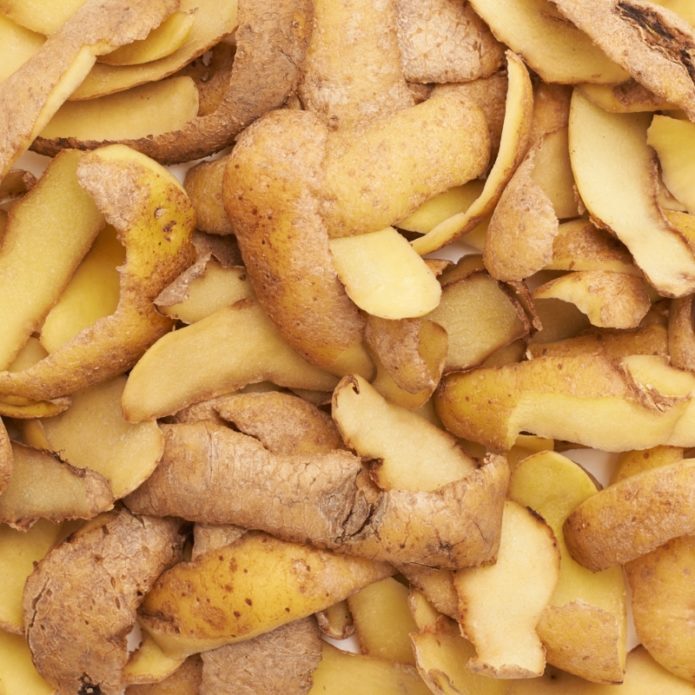
Experienced gardeners collect and dry the peel from potatoes throughout the winter: it contains many trace elements for feeding berry bushes
Landing time and scheme
Optimal month for autumn planting of currants - September (in the middle lane - the second half of the month), but in the south, work can be continued in the first two weeks of October. It is at this time that the currant goes into a state of relative dormancy. About two months remain until real frosts, and the seedling will just have time to take root, the roots will grow in moderation in order to start supplying the shoots with moisture and nutrients in early spring.
In the spring there is very little time for planting currants: usually by the time the soil dries up, the buds are already blossoming on the branches, so you have to work "through the mud". The time for planting in the spring can come both in the first half of April, and even earlier, at the end of March, it is important not to miss it.
In the case of spring planting, the seedlings must be monitored for a long time so that the soil does not dry out, so this option is not suitable for those gardeners who visit the site only once a week.
When developing a site, only one black currant bush is rarely planted: they try to plant several varieties at once, preferably with a different ripening period. At the same time, pollination of flowers occurs better, the yield and quality of berries increase. The usual scheme for planting black currants is 2.5 x 1.5 m, that is, in a row, the distance between the bushes is about one and a half meters, and between rows, with mass planting, up to 2.5 m.
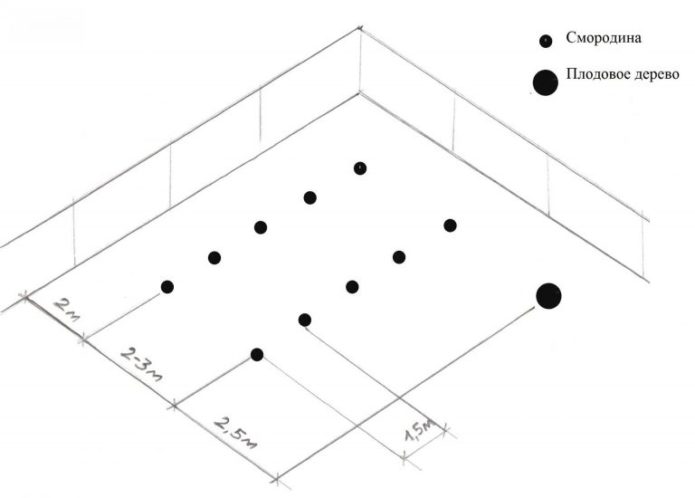
If possible, it is better to leave maximum distances between bushes and rows; this also applies to the distance from the bushes to the fence and trees
Do not give in to the temptation to plant bushes close to the fence: a meter is the minimum distance, it is better to increase it to one and a half. Otherwise, picking berries from an adult bush will be very inconvenient, as a result, you will have to cut out still good fruiting shoots.
Preparation of seedlings
It is best to plant two-year-old seedlings: they take root easily and quickly enter the season of normal productivity. But the seedlings obtained from cuttings of last year's planting are most often quite viable and have a developed root system. It is the roots that are the main thing to look at when purchasing a seedling: the shoots will still have to be cut off almost completely. Having brought the seedling to the site, the roots are slightly cut off from it (usually the very tips of the roots are sluggish, dry, damaged; they are cut to healthy strong wood).
After that, the whole seedlings are placed in water for several hours. Before planting, the roots are completely dipped in a chatterbox made from clay, mullein and water: the solid components are taken equally, and so much water is needed so that the mixture acquires the consistency of sour cream. If there is no mullein at the moment, a chatterbox made only of clay and water will do.

Roots, covered with a layer of clay and mullein, quickly and reliably master the space in the planting pit
Landing technique
The planting of black currant seedlings itself is carried out in the same way as in the case of other berry bushes; differences in spring and autumn are small.
- So much soil is taken out of the planting pit so that the seedling can easily be located in it, and they form a kind of mound on which the seedling is freely placed so that the roots do not bend in an unnatural way.
- Position the seedling at an angle close to 45about, so that the root collar is below the soil level. After the final planting, the depth can be up to 10 cm, so it is immediately made equal to 6–8 cm (the seedling will drop slightly). This technique contributes to the rapid regrowth of young shoots next year.Sometimes currants are planted almost vertically; usually this has to be done if the seedling already contains many shoots and it is not possible to arrange it at an acute angle.
- Gradually, the removed fertile soil is returned to the pit, trying to make sure that all the roots are covered with it without voids. Periodically, the soil is compacted with your hand or foot. After filling the hole, the seedling is carefully watered: 1-2 buckets of water may be required.
- When the water is absorbed, add soil, since it will settle somewhat, and form bumpers from it for subsequent irrigation so that the water does not spread. Water again until water is absorbed.
- Mulch the soil with a layer of 4–6 cm using peat, humus or sawdust.
6. Cut off almost all shoots. Usually only two buds are left on them, but if there is a very strong shoot, you can leave up to four, and the weakest ones, on the contrary, can be cut out near the ground.
The last stage is the saddest: there was just a pretty bush, and we leave almost a few stumps from it. It's okay: it is this kind of pruning that stimulates the development of the root system, the rapid growth of branched shoots and the early appearance of the first harvest.
Video: planting currants in the fall
Caring for black currants after planting
Planting care depends on the state of the weather, and most importantly, the procedure was performed in spring or autumn. Spring planting is risky in the sense of possible drought: winter moisture in the soil quickly ends. Therefore, currants have to be watered weekly, or even 2 times a week. The norm is according to the weather: the soil at the root depth should be properly saturated with moisture, and this may require up to 3 buckets of water. Autumn is easier in this regard: often after planting currants, frequent rains begin. If this does not happen, you have to water as much as in spring.
In the first 2-3 weeks, the seedling, it does not matter - in spring or autumn - should be practically in a liquid, then the requirements for soil moisture become less stringent.
After the autumn planting, the seedling must be covered for the winter. For this, spunbond or spruce branches of conifers are enough; the shelter is carried out in November, just before the frosts. Since the bush is very small after pruning, this is very easy to do. In the coldest regions, it is advisable to arrange a good snowdrift over the currants as the snow falls. A bush planted in spring usually grows well by winter, and no serious shelter is required for the winter.
Spring-planted bushes are closely monitored throughout the season for possible diseases and pest attacks. Prophylactic spraying of young plants in private gardens is usually not carried out, but if there are suspicions of impending disaster, urgent measures must be taken: find out what happened and apply the appropriate drug. Throughout the season, even seemingly harmless weeds are removed and often surface loosening of the soil is carried out.
Video: caring for black currants in the fall
What can be planted next to black currants
Among ordinary vegetables, there are practically no ones that would interfere with the normal development of black currants. It is clear that you should not plant horseradish, which is known for its ability to grow strongly and interfere with other crops. In the aisles of young bushes, there is a place for onions and garlic, which, by emitting phytoncides, heal the air and soil, and drive away pests.
Among berry bushes, honeysuckle is an extremely undesirable neighbor for black currant. A bad neighbor is red currants: they do not interfere with each other, but they have slightly different growing conditions: all varieties of red currants are more photophilous and drought-resistant than black ones. Gooseberries grow well next to black currants, but they have a common enemy - fire, which should be taken into account when planting.
Those plants that form a lot of growth should not be planted next to currants. These are, for example, cherries, raspberries, plums. Strawberries can be put in the same row: the growing mustache, striving to crawl under the currant bushes, will have to be constantly removed. Well, there is no place nearby for such trees that extend their roots far beyond the projection of the crown: this is, for example, an apricot or a walnut.
Features of planting black currants in the regions, including Ukraine
Currant loves a temperate climate, does not feel very well in the heat, in the southern latitudes. Her planting in different regions is almost the same, but the timing may vary, as well as the care of the planted bushes at first. So, in Siberia and the Urals, spring planting is often preferred, since spring comes late, only by early June the air warms up to 10-12 aboutC. But the beginning of winter can be snowless, and the bushes that have not yet taken root, planted in autumn, can die. Here, the "autumn" planting has to be completed before the beginning of September.
In the south of Russia and Ukraine, both spring and autumn planting are practiced equally. Here it is necessary to take into account only the early coming heat, therefore in the spring currants are planted by those gardeners who can practically always be in their plots and water the young bushes in time. In the north of Ukraine, the weather is similar to the weather in the center of Russia and most of Belarus, and mainly currants are planted there in the fall: starting from mid-September and capturing the first ten days of October. If the autumn planting starts earlier, in the event of a warm autumn, which often happens in Ukraine, the growth of young shoots and even budding may begin, which is fraught with the death of the seedling.
Autumn planting is even more popular in such arid regions of our country as, for example, the Lower Volga region. Here spring comes suddenly and progresses very quickly: early spring slush can give way to drought in a matter of weeks. But autumn, on the contrary, is relatively warm and quite long, there is plenty of time for planting currants. But the rains may not start, so in the fall you have to monitor the soil moisture under the young bushes.
Video: spring planting of blackcurrant seedlings with a closed root system
Features of planting certain varieties of black currant
The planting technique for various varieties of black currant is similar, but the distances between the planting pits may differ slightly: there are varieties with more compact bushes, and there are very spreading ones. In addition, different varieties differ somewhat in terms of winter hardiness, which should be considered when choosing between spring and autumn planting. The ripening time of the berries practically does not affect the choice of planting time and its technology: almost all black currant varieties ripen in late June - early July, and only the latest ripening ones - a couple of weeks later.
Finally, there are self-pollinated and cross-pollinated varieties, so it may turn out that when only 1-2 bushes are planted, there will be practically no berries on them. You should first study well the properties of the desired variety and, if necessary, choose a suitable pollinator for joint planting. In addition to the presence of a pollinator variety nearby, to obtain high yields, it may even be necessary to attract bees, which creates additional difficulties, and if the gardener does not have the opportunity for this, it is better to refuse to plant self-infertile varieties.
One of the popular varieties of black currant is the mid-late ripening variety Yadrenaya. The variety is characterized by low spreading and high yield, the tasting rating of very large berries is 4.3 points. The variety is self-fertile, therefore, in principle, it is enough to plant only one bush on the site, it will fully satisfy the needs of a small family. If you plant a two-year-old seedling, you can get a good harvest literally next year. When planting several bushes, the distance between them can be somewhat reduced compared to the usual one: a 2.0 x 1.2 m scheme is normally suitable for the Yadrenaya variety.
But the mid-late Bagheera currant, which was highly popular at the end of the last century, cannot be planted in a dense manner: its bushes are more spreading. The same applies to the not so long ago super popular Belarusian variety Minai Shmyrev, from which, in fact, Bagheera originated.
The Selechenskaya currant, which gives berries of excellent taste, is always popular. However, even the State Register of the Russian Federation warns that this variety is of the "intensive type", that is, to obtain good yields, it requires high soil fertility and constant, proper care. Selechenskaya will certainly please with the harvest, but even when planting, the amount of fertilizer placed in the pit should be increased by one and a half times compared to the usually recommended doses.
It is not difficult to plant black currants, but in order for the harvests to be excellent, and the bush to grow well, planting must be done on time and in accordance with all the rules. In most regions, it is easier to plant in autumn, but often it is necessary to do it in the spring. The site must be selected according to the requirements of the crop and the planting pit is well filled with nutrients.
